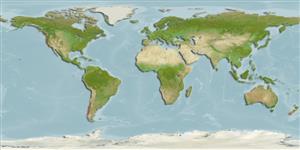>
Perciformes/Zoarcoidei (Eelpouts and pricklebacks) >
Pholidae (Gunnels) > Pholinae
Etymology: Pholis: Greek, pholis, -idos = scale (Ref. 45335); schultzi: Named for L.P. Schultz, Curator of Fishes, U.S. National Museum (Ref. 6885).
More on author: Schultz.
Environment: milieu / climate zone / depth range / distribution range
Écologie
marin démersal; profondeur 0 - 18 m (Ref. 2850). Temperate; 54°N -
Eastern Pacific: Queen Charlotte Islands in British Columbia, Canada to Diablo Cove in central California, USA.
Taille / Poids / Âge
Maturity: Lm ? range ? - ? cm
Max length : 13.0 cm TL mâle / non sexé; (Ref. 2850)
Description synthétique
Morphologie | Morphométrie
Épines dorsales (Total): 84 - 86; Rayons mous dorsaux (Total): 0; Épines anales 2; Rayons mous anaux: 41 - 44. Caudal rounded.
Facultative air-breathing in the genus (Ref. 126274); Found in the intertidal and subtidal, in exposed surge areas (tidal surge channels) and to 18 m depth.
Life cycle and mating behavior
Maturité | Reproduction | Frai | Œufs | Fécondité | Larves
Eschmeyer, W.N., E.S. Herald and H. Hammann, 1983. A field guide to Pacific coast fishes of North America. Boston (MA, USA): Houghton Mifflin Company. xii+336 p. (Ref. 2850)
Statut dans la liste rouge de l'IUCN (Ref. 130435)
Menace pour l'homme
Harmless
Utilisations par l'homme
Plus d'informations
Noms communsSynonymesMétabolismePrédateursÉcotoxicologieReproductionMaturitéFraiRassemblement de ponteFéconditéŒufsDéveloppement de l'œuf
Taille/ÂgeCroissanceLongueur-poidsLongueur-longueurFréquences de longueursMorphométrieMorphologieLarvesDynamique des populations larvairesRecrutementAbondanceBRUVS
RéférencesAquacultureProfil d'aquacultureSouchesGénétiqueElectrophoresesHéritabilitéPathologiesTraitementNutrientsMass conversion
CollaborateursImagesStamps, Coins Misc.SonsCiguateraVitesseType de nageSurface branchialeOtolithesCerveauxVision
Outils
Articles particuliers
Télécharger en XML
Sources Internet
Estimates based on models
Preferred temperature (Ref.
123201): 10.7 - 13.9, mean 11.9 °C (based on 109 cells).
Phylogenetic diversity index (Ref.
82804): PD
50 = 0.5005 [Uniqueness, from 0.5 = low to 2.0 = high].
Bayesian length-weight: a=0.00162 (0.00068 - 0.00388), b=3.19 (2.99 - 3.39), in cm total length, based on LWR estimates for this (Sub)family-body shape (Ref.
93245).
Niveau trophique (Ref.
69278): 3.2 ±0.4 se; based on size and trophs of closest relatives
Résilience (Ref.
120179): Haut, temps minimum de doublement de population inférieur à 15 mois (Preliminary K or Fecundity.).
Fishing Vulnerability (Ref.
59153): Low vulnerability (10 of 100).
